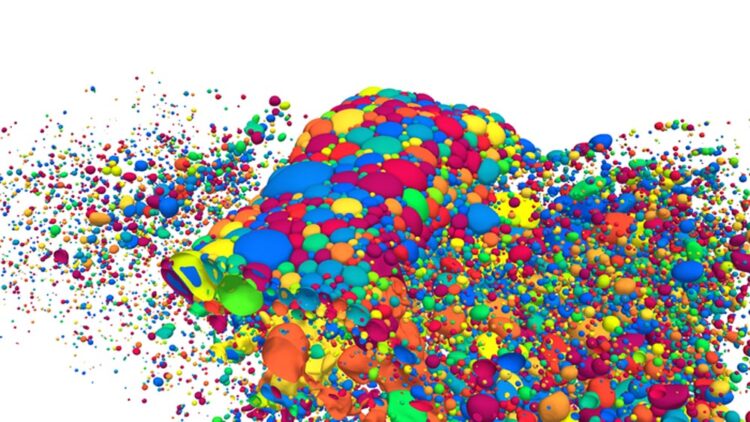Bubbles, bubbles everywhere

A simulation of a foaming waterfall showing bubbles under the surface with arbitrary colors.
Credit: CSE-Lab/Harvard SEAS
Novel method simulates tens of thousands of bubbles in foamy flows.
Bubbles aren’t just for bath time. Bubbles, specifically bubbles in foamy flows, are critical for many industrial processes, including the production of food and cosmetics and drug development and delivery. But the behavior of these foamy flows is notoriously difficult to compute because of the sheer number of bubbles involved.
Previous attempts to simulate foamy flows have relied on the time-consuming and computationally expensive process of tracking the bubbles by color-coating each individual bubble in the foam. This limited simulations to just a few dozen bubbles, instead of the thousands to millions in real foams.
Now, researchers at the Harvard John A. Paulson School of Engineering and Applied Sciences (SEAS) have developed a new way to simulate tens of thousands of bubbles in foamy flows, breaking the computational complexity of this long-standing process.
The research is published in Science Advances.
“This new method allows us for the first time to study foams with many bubbles, opening the door for simulating a wide variety of flows from the micro to the macroscale, including wet foams, turbulent flows with bubbles, suspensions and emulsions in microfluidics,” said Petros Koumoutsakos, the Herbert S. Winokur, Jr. Professor of Engineering and Applied Sciences at SEAS and senior author of the study.
Instead of color-coating each individual bubble, the researchers broke the foam down into a grid, with each cell of the grid containing at most a part of four bubbles. Each bubble inside the cell is color-coated, either yellow, green, blue or red.
“If I have four partial bubbles inside a cell, then the remaining piece of the bubbles have to be in the neighboring cells,” said Petr Karnakov, a graduate student at SEAS and first author of the paper. “We developed an algorithm that can go into other cells and find the remaining pieces of the bubble, matching green to green, blue to blue, etc. So, instead of needing millions of colors, you just need four.”
This capability allows for predictive simulations in scales ranging from microfluidics to crashing waves. “Our new approach allows for large-scale predictive simulations of flows with multiple interfaces,” said Sergey Litvinov, a postdoctoral fellow at ETH Zurich.
The difference between all previous approaches and the new approach developed by Koumoutsakos, Karnakov and Litvinov can be compared to the difference between a painting and a puzzle. A painting is painstakingly created stroke by stroke, while a puzzle relies on geometry and matching colors.
Next, the researchers aim to collaborate with experimentalists and industrial partners to see how the method can be applied in the medical field and the food industry as well as for membrane-less electrolysis for energy applications.
The research was funded by the Swiss National Science Foundation under grant CRSII5_17386.
The authors provide a reference implementation as part of the open-source software Aphros along with more videos and interactive demonstrations of the method.
Journal: Science Advances
DOI: 10.1126/sciadv.abm0590
Media Contact
Leah Burrows
Harvard John A. Paulson School of Engineering and Applied Sciences
lburrows@seas.harvard.edu
Office: 617-496-1351
Media Contact
All latest news from the category: Information Technology
Here you can find a summary of innovations in the fields of information and data processing and up-to-date developments on IT equipment and hardware.
This area covers topics such as IT services, IT architectures, IT management and telecommunications.
Newest articles

Innovative 3D printed scaffolds offer new hope for bone healing
Researchers at the Institute for Bioengineering of Catalonia have developed novel 3D printed PLA-CaP scaffolds that promote blood vessel formation, ensuring better healing and regeneration of bone tissue. Bone is…

The surprising role of gut infection in Alzheimer’s disease
ASU- and Banner Alzheimer’s Institute-led study implicates link between a common virus and the disease, which travels from the gut to the brain and may be a target for antiviral…

Molecular gardening: New enzymes discovered for protein modification pruning
How deubiquitinases USP53 and USP54 cleave long polyubiquitin chains and how the former is linked to liver disease in children. Deubiquitinases (DUBs) are enzymes used by cells to trim protein…



